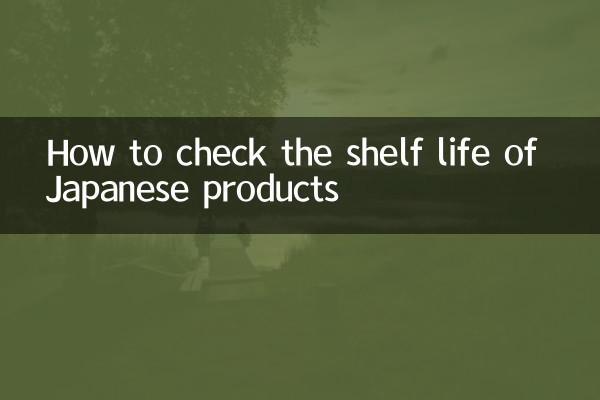How to check the shelf life of Japanese products? Analysis of hot topics across the Internet for 10 days
Recently, discussions about the shelf life of Japanese products have become a hot topic on social media. Especially with the rise of cross-border e-commerce and purchasing agents, consumers have become keenly interested in the shelf life labeling methods of Japanese food, cosmetics and other commodities. The following is a detailed analysis of the shelf life rules of Japanese products based on the hot topic data on the Internet in the past 10 days.
1. Comparison of shelf life labeling methods of Japanese products

| product type | Common labeling forms | Chinese meaning | Validity period calculation |
|---|---|---|---|
| food | Expiration date (しょうひきげん) | Safe to eat expiration date | Accurate to year, month and day |
| cosmetic | Expiration date (しようきげん) | Best before date | 3-36 months after opening |
| drug | Validity period (ゆうこうきげん) | Drug efficacy guarantee period | Accurate to the year and month |
2. Hot topics of discussion on social media
1.Date format difference dispute: Japan uses the "year, month, day" order (May 20, 2024), which is different from China's custom and can easily cause misunderstandings.
2.Hidden shelf life phenomenon: Some snack packages are only marked with the "expiration date" (the period when the flavor is best), but they are actually still safe to eat, causing confusion among consumers.
3.Date issue of purchased goods: Nearly 15% of complaints involve products that are about to expire. Data from a certain platform show that the circulation cycle of imported food from Japan is 2-3 months longer on average than that of domestic products.
3. Interpretation of shelf life of key products
| Popular items | Typical shelf life | Special instructions |
|---|---|---|
| white lover cookies | 120 days (unopened) | Need to be protected from light |
| SK-II fairy water | 3 years (unopened) | 12 months after opening |
| Meiji chocolate | 180 days | Store below 25℃ |
4. Essential identification skills for consumers
1.View JAS logo: Products certified by Japanese agricultural standards will have special shelf life labeling requirements.
2.Pay attention to seasonal limited products: Products limited to the cherry blossom season/red leaf season tend to have a short shelf life. Recent data shows that the expiration rate of such products is as high as 40%.
3.Identify rebranding phenomena: Some unscrupulous merchants will overwrite the original date. It is recommended to check the laser inkjet code (for example, "MM" represents fruit processing).
5. Expert advice
The latest research from the Institute of Food Science, University of Tokyo shows:About 78% of Japanese processed foods are still safe to eat within 1 month of their expiration date(need to be well packaged), except for infant food and fresh food. Consumers are advised to:
• Check specific product standards through the official website of the "Japan Consumer Agency"
• Ask the merchant to provide clear photos of the date when purchasing
• Pay attention to "12M/24M" and other labels on cosmetics before use after opening.
As Japanese products continue to be popular, understanding their shelf life system has become a required course for cross-border consumption. It is recommended to collect the comparison table in this article and check it item by item when purchasing to ensure consumption safety.

check the details

check the details